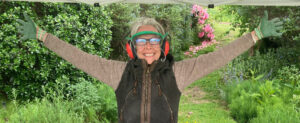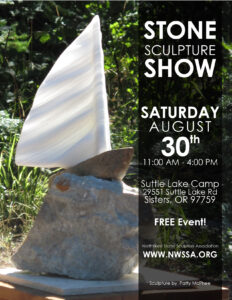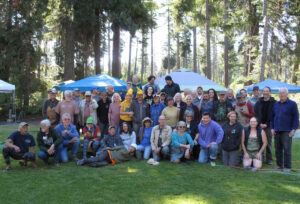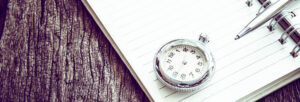
Home » Journal Articles » Thoughts & Opinions » Hearing Conservation for Stone Carving – March/Apr 1999
Top 10 excuses for not using hearing protection
1. I can’t stand anything in my ears
2. I can’t hear my equipment run
3. They hurt my ears
4. I’m too old, what’s been done is already done
5. I’m used to noise
6. I can’t get them in my ears
7. Earplugs give me infections
8. I lost my earmuffs; new ones are too expensive
9. I’m in and out of noise, it’s too much hassle
10. I can’t hear anyway
High sound levels are encountered in creating sculpture; especially true with stone carving. Stone carvers can experience high noise levels from: the tools they use, where they are working, the types of material they are using, and the duration of the exposure to the noise.
Another factor is the anatomical factor; simply that all people do not respond the same to noise as far as physical damage to the ear is concerned. However, over time the effect will be similar.
With repeated and long duration exposure to sound levels above normal conversation, damage to the ear will occur … some will be permanent and some may be reversible.
With proper knowledge of the hazards of uoise, the correct use of protective equipment and knowing the symptoms of hearing damage, working in high noise environments can be carried out safely and healthfully.
As you may know, science and medicine measure noise level in units of sound called decibels which is symbolized as dB. Normal conversation occurs between 60 to 90 dB. Continual, unprotected exposures to noises louder than 85 dB is dangerous and conld eventually result in hearing
What are the noise levels for stone carvers? Shop tools such as drills, sanders, and light duty saws will emit sound levels between 90 to 100 dB and 8 (only) hours a day exposure is considered safe without earprotection.
Chain saws, pneumatic tools and grinders are in the realm of 100 to 115 dB and only 2 hours a day is safe without ear protection.
Proceeding on to higher noise levels, sandblasting noise occurs between 115 and 140 dB and should be limited to IS minutes a day without protection. Even brief exposures above 140 dB, such as dynamite blasting, or jet engine noise, can cause pain and permanent injury without protection.
Location. If you are working close to a sound source or are in a studio with sonnd reflective walls or one with sound absorbing walls, all make a difference to the sound dose experienced.
The time of exposure. The human ear can tolerate short bursts of high intensity sound. But continued exposure over prolonged periods of time will cause severe damage. As an example, a short burst of noise from a sandblaster at 130 dB for 5 minutes is less damaging than a longer exposure of a lower sound level of an air compressor at 110 dB. This is why most industrial regulations and ratings of hearing protection equipment talk about a time weighted average, or dBA, which computes an average of noise exposure over a definite period of lime, usually an 8 hour work shift.
One yard rule. So how can you tell if you need hearing protection in a situation such as a shop or symposium? One rule of thumb: if you bave to shout to be heard at one yard away, you are exceeding 85 dBA and hearing protection should be used. Another is if you are to be working for a long period with a constant noise nearby or in the background, protection should be used even if the noise does not seem to be too bothersome; remember the longer the duration of noise, the more likely the damage.
Physical signs. What are some symptoms that noise exposure is affecting your hearing? Headache; temporary hearing impairment, ringing in the ears, voices sound muffled; or pain in the ears.
Reduce the effects. Remove the source of the noise or muffle the noise is an engineering control. This could mean using another brand of tool or placing a sound absorbing shield or acoustical blanket over or around the noise source if it is a generator or air compressor.
Use mufflers on equipment. Noise barriers can be built over fixed noise sources. An example is enclosing an air compressor or generator from a workroom or studio. Remember there still needs to be adequate ventilation to exhaust excess heat but this venting can be away from the workspace.
Move away from the noise source. Anotherrule of thumb: double the distance from the noise source will reduce 6 dBA. If you are working 10 feet away from a noisy air compressor (say 90 dBA), by moving to 20 feet away you effectively reduce your noise exposure to 84 dBA, an acceptable level. Also, keeping away from corners in a workroom or studio will reduce noise by 6 dBA. Stay away from a sound refleclive surface will drop 3 dBA.
Establish a regular rest period. Another method is an organizational control when working in a noise environment above 85 dBA. Just move to a more quiet environment, say 70 dBA, for 15 minutes to 1/2 hour, or until you are comfortable again. Technically you are waiting for the blood flow on the hearing surfaces of the ear to normalize.
Hearing protection. The best protection are hearing protective devices such as ear plugs. There are a number of varieties that are a soft, flexible foam material that compress easily to fit into the ear canal, then slowly expand to form to the shape of the i ndividual ear. Some of these plugs are disposable after each use, some are reusable and some are corded for wearing around the neck until they need to be used. A factor for stone carvers against the corded type is possible contamination of the ear with grit and dust. Ear plugs come in special designs for hard to fit ears, such as tapered, designed for smaller ear canals, or special proprietary seals for inside the ear for added comfort. Earplugs cost from 15 to 40 cents for uncorded plugs; corded plugs about and special fit plugs about $1.00.
An alternate to ear plugs are earmuffs. These are the type of protection used by tlight deck crew at airports or in industry around heavy machinery. Protection level is less than ear plugs but they have the advantage of more comfort over a long period of lime and offer more protection from low frequency noise (such as the drumming from a fan). Plan to spend $20.00 to $25.00 for earmuffs.
One word of warning: Don’t use your walkman or portable CD with earphones to serve as hearing proteclion. It won’t provide the required protection and could also prevent communications and warnings while working with dangerous equipment. Approved hearing protective devices will not block frequencies of sound necessary for persona] communication.
Not all ear protection is created equal. Each type of hearing proteclion device will have an industrial standard (ANSI) noise reduction rating, or NRR. These ratings will run from 25 dB to 33 dB for earplugs and 26 dB to 29 dB for earmuffs. These ratings are for comparison between devices and do not retlect the actual noise reduction to your ear. Most audiology experts agree that half of that value is the protection level a user will actually receive. The actual protection you will receive onsite for these devices is 12.5 to 16.5 dB for earplugs and 13 to 14.5 dB for earmuffs.
Hearing protective devices are available at industrial safety supply outlets or at some art supply stores.
Don’t underestimate the damage that can come to your hearing while pursuing your passion. For a very small investment and some common sense it shouldn’t be necessary to ask “What’d you say?” as a mark of maturity of a sculptor. “”
Article published by James SekOJ;
© 1999 Site Safety Associates,
Submitted by Patricia Sekor for NWSSA March 1999









We need some kind of descriptive text here.